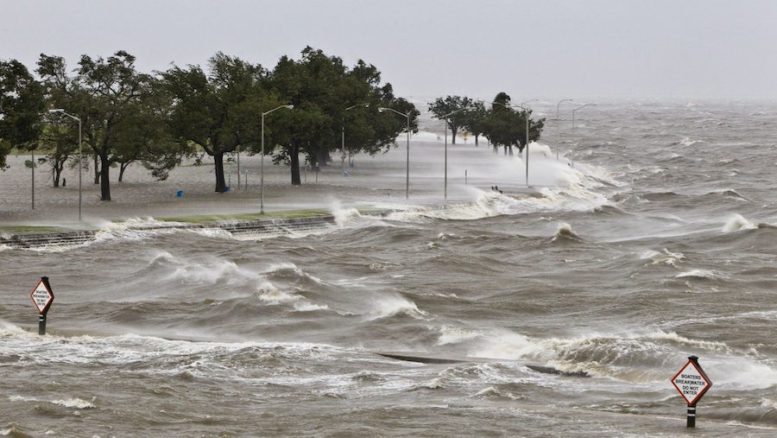
“It’s not that the Netherlands is above sea level, it’s that the sea is above Netherlands level.” Why the Dutch Are Different: A Journey into the Hidden Heart of the Netherlands — Ben Coates.
Just like Miami is “Ground Zero” for sea level issues, Holland is “Europe’s Ground Zero.”
In terms of sea level and its related issues, the Netherlands is unique. The main reason of course is that a huge proportion of the entire country lies under sea level. Simply put, the Dutch must be mindful of the ocean, live with the ocean, and endure the ravages of the ocean.
Since 1900, sea level rise of the North Sea near the Dutch coast has been approximately 19 centimeters (which is a little bit more than seven inches) and is compatible with the global average. (It should be kept in mind that for the last 100 years, the mean sea level throughout the world has risen at about three millimeters per year, which is approximately one foot per century).
But there are recent indications of worsening conditions, particularly for coastal areas susceptible to storm surges. And that brings us to…
The Problem of Storm Surges:
Besides the sheer issue of living below sea level, coastal regions such as Rotterdam and Miami, also need to prepare for storm surges that can lift the seas another five to ten feet. For that reason, in 1997 the Dutch built an enormous barrier called the “Maeslant barrier” in order to protect Rotterdam from potential storm surges. In designing the enormous seawall, which extends 22 meters high and 210 meters long (72 feet high and 689 feet long), the Dutch sought to protect themselves from the absolute worst-case scenario storm, even if it meant shelling out a high capital cost. One senses that the Dutch look at things more in the long term than Americans, and are willing to implement a preventive, high-cost measure, paying for it over a set amount of years rather than waiting for catastrophe to strike.
Perhaps they learned the lesson of Galveston in Texas, which was hit by the worst natural disaster in American history in the year 1900. The unnamed hurricane took approximately 8,000 lives and basically wiped out Galveston. Nevertheless, the people of Galveston decided that they wanted to live in their barrier island and built a structure around the entire city which rises more than five meters (16 feet) and extends 55 miles.
Now let’s get back to Rotterdam and its peculiar battle with the sea.
About Rotterdam:
The largest port in Europe lies approximately 30 miles west of downtown Rotterdam, where the Rhine River empties into The North Sea. The Dutch are currently investing another $3 billion into this area and are also installing a 14 meter-high seawall, which takes into account the highest-risk scenario of sea level rise by the year 2060.
The Dutch are not only exemplary leaders of preparedness, but they found solace in the utilization of old yet classic technologies that should not be underestimated. The Dutch have been managing a system of windmills, canals, dikes, levees and storm surge barriers for hundreds of years, which is a contributing factor in keeping the country dry. In the realm of new urban technologies, they have even begun experimenting with solutions that include floating buildings. Holland’s past is Miami’s present.
Miami’s Recent Past: A Scary Scenario
Most of Miami-Dade lies between one and three meters above sea level (3-10 feet). Collins Avenue on Miami Beach, for example lies three feet above sea level, which means that a storm surge of five feet which accompanies a Category 1 storm will flood parts of Collins Avenue that are not shielded by dunes and bay walks which can slow down or even stop surge. The same is true for South Bayshore and the coastal facilities in my district, such as Vizcaya, Deering Estate and Fairchild Tropical Gardens. If we knew for sure that sea level would rise between two and three feet before the end of the century, as some models are suggesting, we would have to implement the kind of measures that have been discussed for Miami Beach, including raising street levels and building substantial seawalls such as the ones mentioned for Rotterdam and Galveston.
The key to analyzing Miami-Dade’s prospects for sea level rise, is understanding the remarkable exponential surge that we have seen since the turn of the century. More specifically, Miami-Dade has seen an increase in the level of the bay that is five to seven times higher than the global average of three millimeters per year. I credit South Miami Mayor Phil Stoddard with a possible explanation for this, which is based on the increased height of the Gulfstream—itself the result of a slowing down as it reaches the northern coast and is forced to dip suddenly under the fresh water being released by melting ice caps of the Arctic and Greenland.
The reader (as well as many an expert in our metropolis), might be confused by the fact that sea levels experienced at the main National Oceanic and Atmospheric Administration (NOAA) facility, located in Key West, mirror the global average of three millimeters per year. But the measurements that count for us in Miami-Dade, particularly on the eastern bay side of the county, are the readings obtained by the NOAA facility located at the Rickenbacker Causeway. Those have revealed a scary increase in sea levels; if continued another 30 years, we could see two or three feet by mid-century! Which is why we are especially attentive to trends.

And that brings us to…
Future Trends Locally and Globally:
My staff and I have been monitoring carefully sea levels and storm surges in both Miami Beach and the portions of my district that lie next to the coast. It is fair to say that since 2014, there appears to be a slowdown both in sea level rise and storm surges. It is entirely possible that the accelerated phenomenon of the first decade and a half of the century will not be repeated going forward; however, there is not enough data yet to make that prediction.
One global factor which must be monitored is the accumulation of snow over Antarctica, which results from increasing temperatures that allow the atmosphere to carry more humidity. Recent measurements indicate that this could be a factor in slowing down sea level rise, although there is great dispute about the accuracy of such measurements, which require not only precise readings of area covered by ice, but thickness of the ice.
Conclusion:
Admittedly we are dealing with an uncertain future. For that reason, all of us who are involved in local government must monitor carefully, not only rising seas, but the related phenomenon of saltwater intrusion, which takes on a new urgency when groundwater levels begin to equalize with sea levels.
Secondly, we must take the long-term approach when we build new infrastructure, such as water treatment plans. In that connection, we must design these to withstand not only creeping sea levels but also catastrophic storm surges, such as endured by New York and New Jersey during superstorm Sandy.
Last but certainly not least, we need to be attentive to the data and continue the analysis that shows a correlation between sea level rise and global warming. There is no need to be alarmist, but there is also no justification for being ignorant or dismissive of the facts.
Miami-Dade County Commissioner Xavier L. Suarez can be reached at 305-669-4003 or via email at district7@miamidade.gov.






